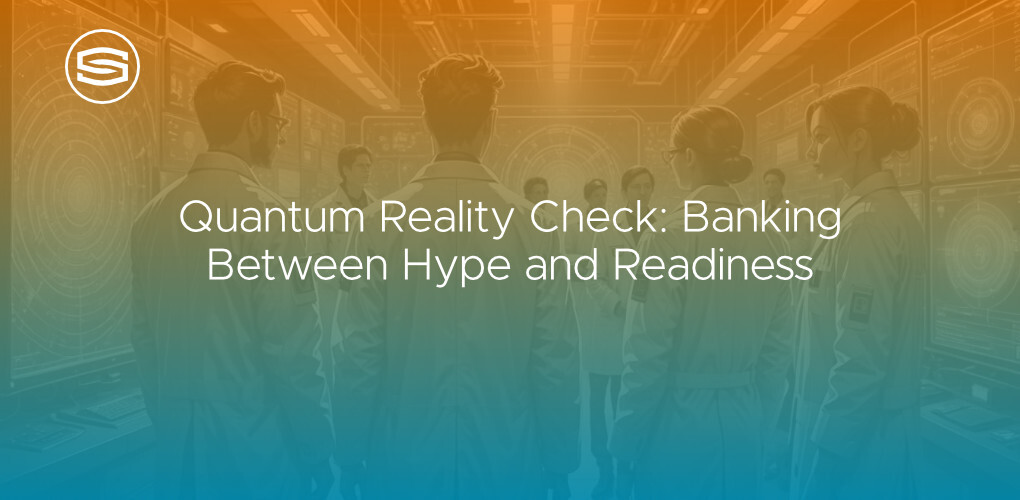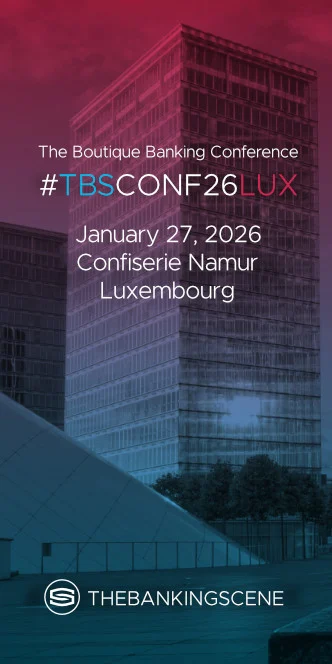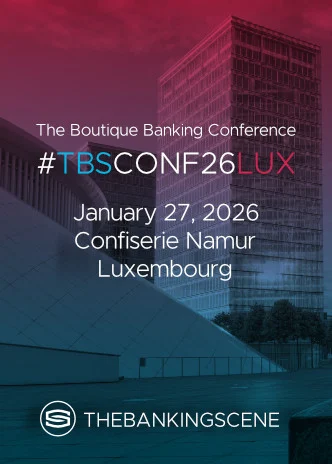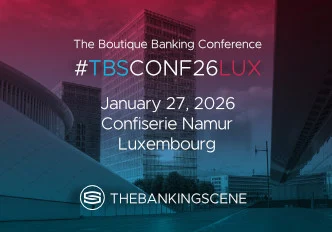
Insights & Opinions
Quantum Reality Check: Banking Between Hype and Readiness
Tue, 04 Nov 2025


When Juan Elias, Director of Digital Enablers for Americas, UK and Ireland, asked me at the last-minute request to moderate a quantum panel at SIBOS, I didn’t hesitate. I knew it would be a challenge: few topics are as complex, but what an incredible opportunity to talk to some of the brightest minds on a topic that may turn the digital world as we know it upside down.
For the panel, I had spoken to each of the panellists in the days leading up to our session. I knew their lines of thinking, although I didn’t always understand it 100%. Luckily, a few nights earlier, I met Andrea Morello, Professor of Quantum Engineering at Australia University, New South Wales and one of the world’s most articulate voices in quantum engineering. I joined him for breakfast a day later and attended his session “Speaking Quantum: Lost in Translation”.
Still, when theory turned into a live debate, the conversation took on a new energy.
My panel, “The quantum countdown: Do we need to redefine trust, risk and security for the next decade?” brought together the following experts:
- Escolástico Sánchez Martínez, Quantum Head at BBVA
- Stacey Jeffery, Senior Researcher at CWI and Professor of Quantum Information at the University of Amsterdam
- Stefan Woerner, Global Leader for Quantum Finance and Optimisation at IBM Research in Zurich.
Quantum computing is a topic surrounded by mystery and misunderstanding, but at its heart lies a very practical question: how do we prepare today for something that will matter tomorrow, something that will rewrite the rules of cybersecurity as we know it today?
Quantum is not ready for banking. But banking needs to be ready for quantum.
The Paradox of Quantum: A Threat and a Promise
No one expressed this duality better than Sánchez Martínez, who described quantum as a technology we must view “in two directions at once.” One direction reveals the threat: the power to break today’s cryptography and the digital trust we take for granted. The other shows the promise: solving problems that classical computers cannot, from risk modelling to fraud detection.
As Andrew Vorster noted in his earlier Banking Scene piece “One Qubit at a Time”, innovation in this space is “not about replacing classical systems but augmenting them.” His point, that quantum and AI are complementary, not competing, was echoed repeatedly in our panel.
Every technological shift begins with risk before becoming a necessity. Unlike previous innovations, the problem with quantum is that timings are uncertain, and the impact could be potentially devastating. The threat may seem distant, yet the actions we take now will determine how vulnerable or prepared we are when that moment arrives.
The Urgency We Don’t Yet Feel
Stefan Woerner from IBM Research Zurich offered one of the clearest explanations of why we can’t afford complacency. He estimates that it will take roughly 2,000 error-corrected qubits to break today’s encryption: something IBM expects to reach by around 2033.
Reaching 2,000 of those logical qubits would mean we can finally run Shor’s algorithm, the famous formula that can break RSA and other public-key encryption methods. In plain terms, that’s the moment when today’s digital security, the one protecting our payments, identities, and financial data, begins to collapse.
IBM expects that milestone sometime around 2033, but the paradox is that the risk begins earlier. Data intercepted and stored today can be decrypted later, once those 2,000 qubits exist. The concept is known as “harvest now, decrypt later”, and it’s the reason why banks can’t afford to wait for proof before they act.
BBVA’s Quantum Safety Programme is already mapping encryption dependencies and preparing to migrate to post-quantum cryptography.
In that sense, the 2,000-qubit milestone is a reminder that trust, once again, depends on foresight.
As Sánchez Martínez put it, “We must be able to move from one protection to another very quickly.”
Quantum Advantage: Still an Experiment, Not a Strategy
If the risks are already tangible, the rewards are still theoretical. Stefan reminded us that we’re entering the era of quantum utility, where machines can perform calculations too complex for classical computers, though not yet commercially useful.
That nuance matters. It means banks won’t see business benefits from quantum computing probably for years. What they can gain is understanding.
Early experiments are taking place in areas such as portfolio optimisation, risk simulations, and quantum-inspired machine learning.
A recent example comes from HSBC, which, together with IBM, reported a quantum-computing trial in bond trading that improved trade-execution prediction accuracy by up to 34 percent. The quantum component transformed how data features were represented; the classical system still did the analysis. It’s an early proof that quantum can enhance, rather than displace, classical computing.
Yet even HSBC was clear: this is not quantum advantage, not yet. The project was about quantum-inspired improvement, not full replacement.
These initiatives are not production projects; they’re learning projects, a chance to explore what quantum might one day do better. And while that’s a tough business case to sell to a board focused on short-term ROI, it’s precisely this long-term investment in understanding that defines the banks which will lead when the advantage finally arrives.
Stefan put it well: “Quantum computing won’t replace classical computing; it will augment it. The future is hybrid: classical, quantum, and AI working together.”
Collaboration as a Survival Strategy
When I asked about the need for collaboration, Sánchez Martínez’s answer stood out: “If we agree that the financial industry is good for society, we must defend it collectively before competing individually.”
He recalled past sector-wide initiatives: SWIFT, Y2K, cybersecurity coalitions, as examples of shared survival. Quantum requires the same unity. When one institution’s defences fail, confidence across the system suffers.
This continues the theme Andrew raised in One Qubit at a Time: quantum progress will depend on collaboration between regulators, technology providers, and financial institutions. In a hyper-connected ecosystem, a shared infrastructure based on collaboration is what brings the trust we need to get ready for this new technology.
A Call for Quantum Literacy
Stacey Jeffery, from CWI Amsterdam, brought a welcome dose of realism: “We cannot currently do anything useful with any quantum computer that exists today.”
Her point wasn’t to dismiss the technology, but to clarify its stage of development. Many people still misunderstand what quantum physics is or misinterpret headlines about progress. When a company claims to have built a “6,000-qubit computer”, it sounds revolutionary, until you look closer. As Stacey explained, that machine was a quantum annealer, not a universal quantum computer like those IBM or Google are developing.
A quantum annealer uses quantum effects to explore optimisation problems but in a narrow, specialised way. Its qubits aren’t fully entangled or error-corrected. It’s a useful tool for research, not a machine that will break encryption or power trading systems.
Jeffery’s argument for quantum literacy is critical. Banks don’t need physicists on their boards, but they do need executives who can separate hype from substance, and regulators who can judge when readiness turns into responsibility.
Quantum is difficult enough without miscommunication getting in the way.
A Lesson in Language
That brings me back to Andrea Morello, the quantum engineer I mentioned earlier. In his session, he explained: “Quantum mechanics describes physical objects whose behaviour is affected by the Heisenberg uncertainty principle. Nothing can ever be completely still: everything has some uncertainty.”
That uncertainty, when harnessed, becomes the essence of quantum computing. Andrea illustrated this beautifully: a classical bit sits at 0 or 1, but a qubit can point anywhere on a sphere between them. Entanglement means two of those vectors no longer make sense on their own; you can’t describe one without the other.
He turned abstraction into geometry and made the quantum world feel less like mystery and more like physics in motion. If you’re interested, this is one of his YouTube videos where he explains it (300,000 others viewed it before you).
That lesson applies just as much to bankers as to physicists. We, too, need a new language, one that allows us to talk meaningfully about what quantum means for trust, risk, and innovation.
Learning to Walk in Quantum
The conversations confirmed what I had already sensed in those earlier calls and conversations: that across science and finance, we are beginning to speak a shared language of curiosity, caution and opportunity.
Quantum computing is not production-ready, but that’s precisely why now is the time to engage. Banks that begin to understand the concepts, test small experiments, and build agile defences will be far better positioned when quantum moves from the lab to the market. Those who wait for certainty may find they’ve waited too long.
As one of the panellists said, with quiet conviction: “This is not science fiction. It’s science, and science eventually takes its course.”
Quantum readiness is about being intellectually and strategically prepared for it. The leap will come. For now, the work is to learn.
For you, but also for me. Because without the experts’ insights, I couldn’t have written this blog.
I’m not an expert, just a messenger.
The Banking Scene: Director's Cut
Join us as we delve into the fascinating world of quantum computing and its potential impact on the banking industry with insights from a panel with IBM, BBVA, and CWI at SIBOS and earlier sessions at our own conferences and beyond.
We discuss the complexities of quantum technology, its dependence on AI, and the hybrid future of computing. Discover insights from industry experts on how quantum computing could revolutionise financial services and the importance of collaboration in navigating this technological frontier in the video below, or follow on your favourite podcast platform here.



